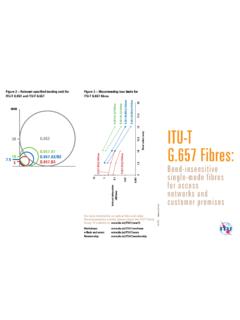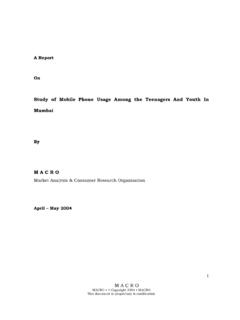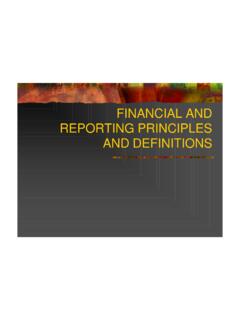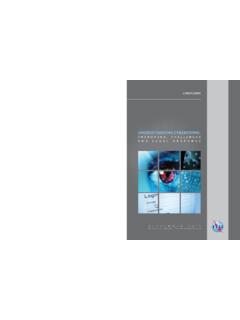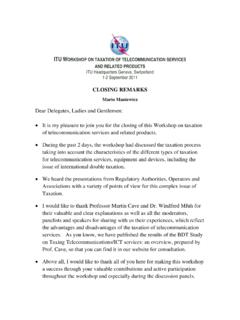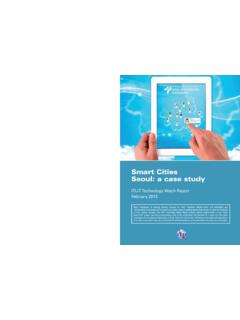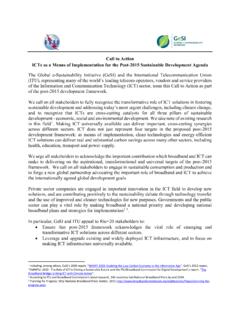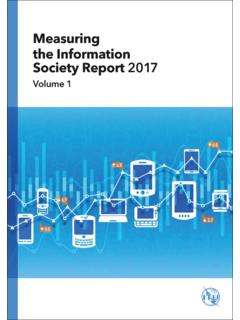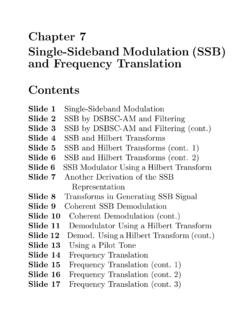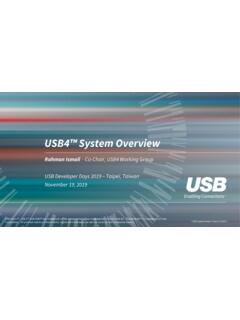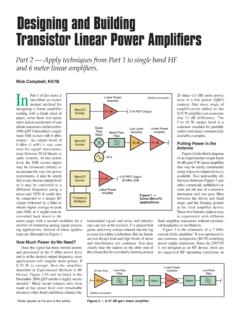Transcription of Classification of emissions and necessary bandwidths
1 APPENDIX 1 ( ) Classification of emissions and necessary bandwidths (See Article 2) 1 1) emissions shall be designated according to their necessary bandwidth and their Classification as explained in this Appendix. 2) Formulae and examples of emissions designated in accordance with this Appendix are given in Recommendation ITU-R Further examples may be provided in other ITU-R Recommendations. These examples may also be published in the Preface to the International Frequency List. (WRC-12) Section I necessary bandwidth 2 1) The necessary bandwidth , as defined in No. and determined in accordance with the formulae and examples, shall be expressed by three numerals and one letter.
2 The letter occupies the position of the decimal point and represents the unit of bandwidth . The first character shall be neither zero nor K, M or G. 2) necessary bandwidths1: between and 999 Hz shall be expressed in Hz (letter H); between and 999 kHz shall be expressed in kHz (letter K); between and 999 MHz shall be expressed in MHz (letter M); between and 999 GHz shall be expressed in GHz (letter G). 3) For the full designation of an emission, the necessary bandwidth , indicated in four characters, shall be added just before the Classification symbols. When used, the necessary bandwidth shall be determined by one of the following methods: ) use of the formulae and examples of necessary bandwidths and designation of corresponding emissions given in Recommendation ITU-R ; (WRC-12) ) computation, in accordance with other ITU-R Recommendations; ) measurement, in cases not covered by ) or ) above.
3 _____ 1 Examples: Hz = H002 6 kHz = 6K00 MHz = 1M25 Hz = H100 kHz = 12K5 2 MHz = 2M00 Hz = 25H3 kHz = 180K 10 MHz = 10M0 400 Hz = 400H kHz = 181K 202 MHz = 202M kHz = 2K40 kHz = 181K GHz = 5G65 Section II Classification 3 The class of emission is a set of characteristics conforming to 4 below. 4 emissions shall be classified and symbolized according to their basic characteristics as given in Sub-Section IIA and any optional additional characteristics as provided for in Sub-Section IIB. 5 The basic characteristics (see Sub-Section IIA) are: 1) first symbol type of modulation of the main carrier; 2) second symbol nature of signal(s) modulating the main carrier; 3) third symbol type of information to be transmitted.
4 Modulation used only for short periods and for incidental purposes (such as, in many cases, for identification or calling) may be ignored provided that the necessary bandwidth as indicated is not thereby increased. Sub-Section IIA Basic characteristics 6 1) First symbol Type of modulation of the main carrier ) Emission of an unmodulated carrier N ) Emission in which the main carrier is amplitude-modulated (including cases where sub-carriers are angle-modulated) ) Double- sideband A ) single - sideband , full carrier H ) single - sideband , reduced or variable level carrier R ) single - sideband , suppressed carrier J ) Independent sidebands B ) Vestigial sideband C ) Emission in which the main carrier is angle-modulated ) Frequency modulation F ) Phase modulation G ) Emission in which the main carrier is amplitude-and angle-modulated either simultaneously or in a pre-established sequence D )
5 Emission of pulses2 ) Sequence of unmodulated pulses P _____ 2 emissions where the main carrier is directly modulated by a signal which has been coded into quantized form ( pulse code modulation) should be designated under ) or ). 3 CMR12/2055-E ) A sequence of pulses ) modulated in amplitude K ) modulated in width/duration L ) modulated in position/phase M ) in which the carrier is angle-modulated during the angle-period of the pulse Q ) which is a combination of the foregoing or is produced by other means V ) Cases not covered above, in which an emission consists of the main carrier modulated, either simultaneously or in a pre-established sequence, in a combination of two or more of the following modes.
6 Amplitude, angle, pulse W ) Cases not otherwise covered X 2) Second symbol Nature of signal(s) modulating the main carrier ) No modulating signal 0 ) A single channel containing quantized or digital information without the use of a modulating sub-carrier3 1 ) A single channel containing quantized or digital information with the use of a modulating sub-carrier3 2 ) A single channel containing analogue information 3 ) Two or more channels containing quantized or digital information 7 ) Two or more channels containing analogue information 8 ) Composite system with one or more channels containing quantized or digital information, together with one or more channels containing analogue information 9 ) Cases not otherwise covered X 3) Third symbol Type of information to be transmitted4 ) No information transmitted N ) Telegraphy for aural reception A ) Telegraphy for automatic reception B ) Facsimile C ) Data transmission, telemetry, telecommand D _____ 3 This excludes time-division multiplex.
7 4 In this context the word information does not include information of a constant, unvarying nature such as is provided by standard frequency emissions , continuous wave and pulse radars, etc. ) Telephony (including sound broadcasting) E ) Television (video) F ) Combination of the above W ) Cases not otherwise covered X Sub-Section IIB Optional characteristics for the Classification of emissions 7 Two optional characteristics should be added for a more complete description of an emission. These are: Fourth symbol Details of signal(s) Fifth symbol Nature of multiplexing Where the fourth or fifth symbol is used it shall be as indicated below. Where the fourth or the fifth symbol is not used this should be indicated by a dash where each symbol would otherwise appear.
8 1) Fourth symbol Details of signal(s) ) Two-condition code with elements of differing numbers and/or durations A ) Two-condition code with elements of the same number and duration without error-correction B ) Two-condition code with elements of the same number and duration with error-correction C ) Four-condition code in which each condition represents a signal element (or one or more bits) D ) Multi-condition code in which each condition represents a signal element (of one or more bits) E ) Multi-condition code in which each condition or combination of conditions represents a character F ) Sound of broadcasting quality (monophonic) G ) Sound of broadcasting quality (stereophonic or quadraphonic) H ) Sound of commercial quality (excluding categories given in ) and )) J ) Sound of commercial quality with the use of frequency inversion or band-splitting K ) Sound of commercial quality with separate frequency-modulated signals to control the level of demodulated signal L 5 CMR12/2055-E ) Monochrome M ) Colour N ) Combination of the above W ) Cases not otherwise covered X 2) Fifth symbol Nature of multiplexing ) None N ) Code-division multiplex5 C ) Frequency-division multiplex F ) Time-division multiplex T )
9 Combination of frequency-division multiplex and time-division multiplex W ) Other types of multiplexing X _____ 5 This includes bandwidth expansion techniques.

